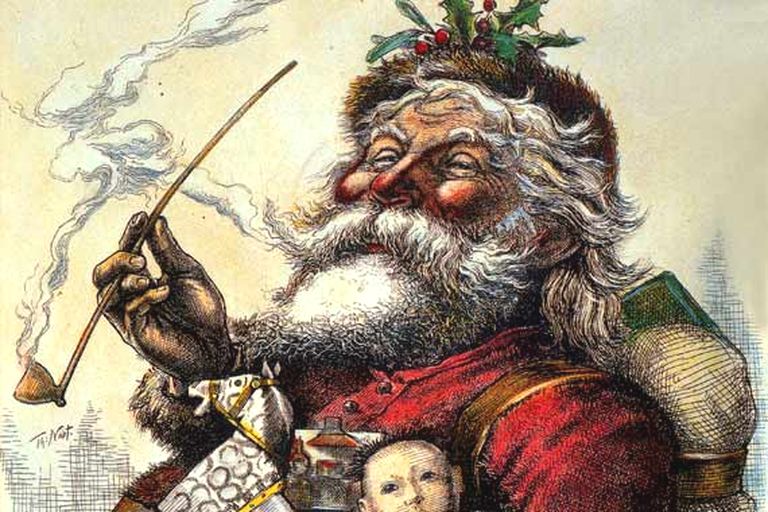St. Nicholas was born around 280 in present-day Turkey. According to legend, he gave away his inherited fortune to the poor. In the most famous story, he kept three sisters out of slavery or prostitution by dropping bags of gold down their chimney for their dowries. He was depicted as a bearded bishop in robes. The leaving of gifts for children was added on later. His feast day was Dec. 6. On the eve, it became a tradition in Europe to leave treats in children’s shoes. Although he was one of the most popular saints of the Middle Ages, the Reformation made veneration of saints out of vogue. But the idea of leaving presents for kids could not be ended. Martin Luther pushed the belief in Christkind (Kris Kringle in America). He was a golden-haired winged baby Jesus who left gifts for good boys and girls. He was popular in Germany, Austria, and Switzerland. In England, around the time of Henry VIII, St. Nicholas was replaced by St. Christmas, Father Christmas, or Old Man Christmas because someone had to continue the gift-giving. The day was moved to Dec. 25 to coincide with Jesus’ birthday. He was depicted as wearing green or scarlet robes lined with fur. The Dutch brought their equivalent to colonial America as Sinter Klaas in the 1700’s. Woodcuts in the early 1800’s showed stockings with toys and fruits hanging over the fireplace. In 1809, Washington Irving mentioned him in a book as “Santa Claus”. Images varied with one popular look being with a blue, three-cornered hat, a red waistcoat, and yellow stockings. Stores began advertising Christmas shopping in the 1820’s and by the 1840’s Santa Claus first appeared in the ads. Soon, live Santas became part of Christmas promotions by stores. By then, today’s image was evolving. In 1821, an anonymous poem entitled “Old Santa Claus with Much Delight” added the reindeer sleigh. In 1823, Clement Clarke Moore wrote “An Account of a Visit from St. Nicholas” (soon to be known as “Twas the Night Before Christmas”) for his three daughters. (Some historians believe his authorship was bogus and the actual author was Henry Livingston, Jr.). The story established that Santa was fat, jolly, and old. He had an eight reindeer sleigh. He named the reindeer. In 1863, famous cartoonist Thomas Nast drew Santa as wearing a stars and stripes suit! By 1881, he had adjusted his character to a red suit with a white beard. Nast invented the idea of a workshop with elves at the North Pole. The public adopted Nast’s Santa after seeing him in numerous Harper’s Weekly issues. By the 1890’s, the Salvation Army pushed the image by dressing unemployed men up in red costumes, giving them bells, and asking for donations in front of stores around Christmas time. Coca-Cola put its stamp on the image starting in 1931. Hadoon Sundblum made the decision to draw him as extra chubby. In 1939, Rudolph was invented by Robert May for Montgomery Ward. His story sold 2 ½ million copies. In 1949, his friend Johnny Marks wrote the song which was recorded by Gene Autry. The TV show first aired in 1964.
https://www.history.com/topics/christmas/santa-claus
https://www.whychristmas.com/customs/fatherchristmas.shtml
https://en.wikipedia.org/wiki/Santa_Claus

Thomas Nast’s 1881 Santa
0 Comments